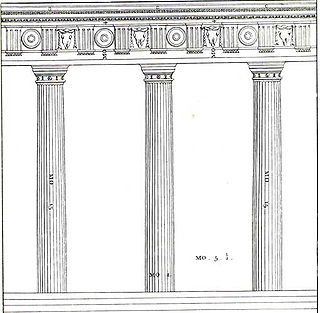
Vitruvian module
Encyclopedia

Classical architecture
Classical architecture is a mode of architecture employing vocabulary derived in part from the Greek and Roman architecture of classical antiquity, enriched by classicizing architectural practice in Europe since the Renaissance...
, corresponding to the semidiameter of the column
Column
A column or pillar in architecture and structural engineering is a vertical structural element that transmits, through compression, the weight of the structure above to other structural elements below. For the purpose of wind or earthquake engineering, columns may be designed to resist lateral forces...
at its base. The term was first set forth by Vitruvius
Vitruvius
Marcus Vitruvius Pollio was a Roman writer, architect and engineer, active in the 1st century BC. He is best known as the author of the multi-volume work De Architectura ....
(book iv.3), and was employed by architects in the Italian Renaissance
Renaissance
The Renaissance was a cultural movement that spanned roughly the 14th to the 17th century, beginning in Italy in the Late Middle Ages and later spreading to the rest of Europe. The term is also used more loosely to refer to the historical era, but since the changes of the Renaissance were not...
to determine the relative proportions of the various parts of the Classical orders. The module was divided by the 16th century theorists into thirty parts, called minutes, allowing for much greater precision than was thought necessary by Vitruvius, whose subdivision was usually six parts.
When illustrating Palladio
Andrea Palladio
Andrea Palladio was an architect active in the Republic of Venice. Palladio, influenced by Roman and Greek architecture, primarily by Vitruvius, is widely considered the most influential individual in the history of Western architecture...
, the British architect Isaac Ware (The Four Books of Andrea Palladio's Architecture, London 1738; illustration, right) laid out the Doric order
Doric order
The Doric order was one of the three orders or organizational systems of ancient Greek or classical architecture; the other two canonical orders were the Ionic and the Corinthian.-History:...
as an exercise in modular construction. The module he selected was a full column diameter taken at the base. He set his columns, 15 modules tall, at an intercolumniation of 5½ modules. His architrave and frieze, without the cornice, is equal to one module.
The tendency in Beaux-Arts architectural training was similarly to adopt the whole columnar diameter as the module when determining the height of the column or entablature or any of their subdivisions.
Thus module can be extended to mean more generally a unitary part that gives the measuring unit for the whole. In education, for example, lessons may be divided into modules.

